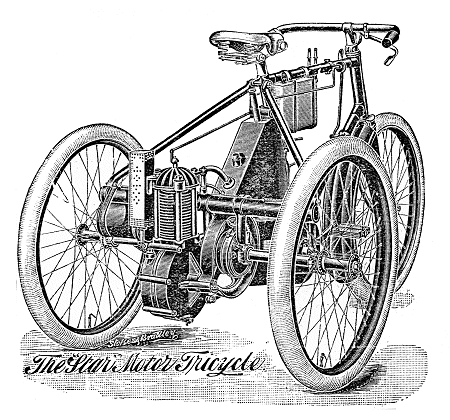 |
It all began in 1876 when Edward Lisle and Edwin
John Sharratt founded Sharratt and Lisle, in order to
manufacture cycles. Their factory in Pountney Street,
Wolverhampton was known as the Star Cycle Works. The partnership
lasted for just 3 years, after which Edwin Sharratt left to
start his own separate business.
In 1883 Edward Lisle founded the Star Cycle
Company, but continued to sell his machines under the Sharratt &
Lisle name until 1896, when he founded the Star Cycle Company
Limited, with a starting capital of £120,000. He produced large
numbers of cycles and cycle components at his factory in Stewart
Street, Wolverhampton. Star produced its first motorised cycle in 1899
in the form of the Star Motor Tricycle, which was based on a
popular De Dion machine. |
| The first Star motorcycle appeared in 1902. The machine,
called the 'Griffon' was initially imported from France where it
was a popular machine. The machine sold for £42. |
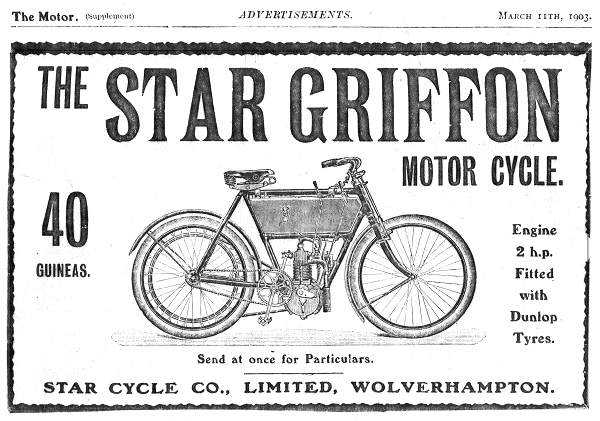
An advert from 1903.
| In 1903 Star began to produce
the 'Griffon' in Wolverhampton, and soon launched a 3 hp. model
with trembler-coil ignition, two 4 volt accumulators, and a
selling price of £42. The machine was also available with a
Bowden free engine clutch, for an extra £6. |
| The machines had some success in trials and
competitions. The best performance in the Dublin Reliability
Trial, held on 12th September, 1903, was by Mr. P. W.
Stevens, Star's Irish agent, riding a Star 'Griffon'. In
1904 Star exhibited three models at the Stanley Cycle Show
in the Agricultural Hall, Westminster, London. The first,
the Star Tricar was fitted with a 4 hp. water-cooled Star
engine, a Longuemare Model 'H' carburettor, an E.I.C.
trembler coil, two Castle 4 volt accumulators, and a 2 gallon
petrol tank. It had a Brampton chain drive, a Bowden band brake at
the front, a pedal-operated rear brake, 2½
in. Dunlop tyres, a 2-speed and free engine gearbox in the
rear hub, and a selling price of 65 guineas.
The second model was a
motorcycle with the following specification: A 4 hp.
water-cooled Star engine, a Longuemare Model 'H'
carburettor, an E.I.C. trembler coil, two Castle 4 volt
accumulators, a 2 gallon petrol tank, a Lycett's belt drive,
a Crabbe front rim brake, a rear Bowden brake, a Bowden
exhaust valve lift, and 2 in. Dunlop tyres. The machine sold
for 46 guineas.
The third model was another motorcycle, which was powered
by a 2¾ hp. air-cooled Zedel
engine. The Star Tricar was in direct competition with
another locally-made vehicle that was displayed at the show,
the Wolf Tricar. |
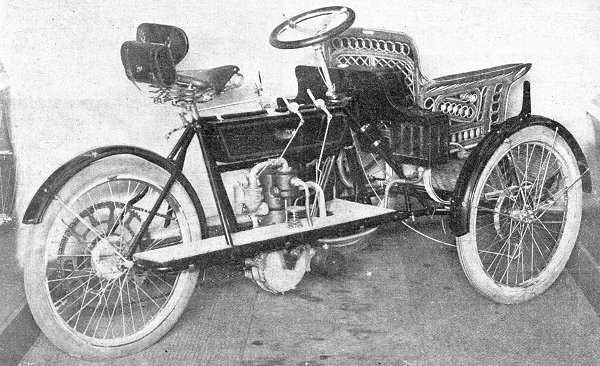 |
The Star Tricar. |
| Star's exhibits at the Stanley Show are described in the
following article from 'The Motor Cycle' magazine, published on
28th November, 1904. |
|
The Star Cycle Company Limited,
Wolverhampton (Stand 133), are another firm who have
become alive to the fact that there is a great
demand for a well-designed tricar. Their machine is
fitted with a 4hp. water-cooled engine, the water
circulation being on the thermo-syphon system. The
transmission is by chain direct from the engine to
the back wheel.
An epicyclic gear is contained
in the back hub, and is operated by two levers, a
foot lever which applies a brake to the hub and
throws the low gear into operation, and the large
lever on the top tube, which works the high gear.
Wheel steering is fitted, and on the wheel there is
a Bowden lever working the front and wheel brakes,
which, by the way, are of large diameter, and look
remarkably efficient. On the other side there is a
pedal working a back rim brake. The coil and
accumulators are carried in a large box fixed on the
footboard, and the wiring is well protected against
wet.
| Two bicycles are also shown on this
stand. One a 2¾ hp. fitted with an
air-cooled Zedel engine, weighing only
112 lbs., the other being a 4 hp.
water-cooled machine.
The water circulation is on the
thermo siphon system, and the pipes are
made of flexible tubing. The radiators
are contained in the tank, and that
portion of the tank which contains the
water is separated from the other
portion, and is intersected by fourteen
small tubes, through which the air is
allowed to circulate for cooling
purposes.
One noteworthy feature on this
machine is the long levers which are
used, these allowing very nice
adjustment. |
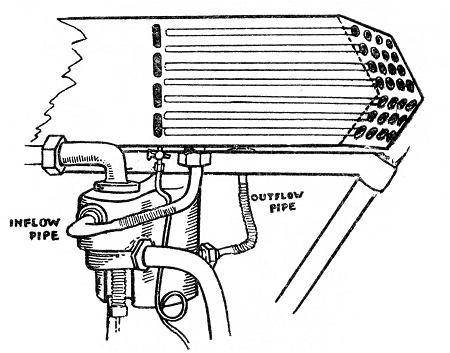
The arrangement of water tank,
radiators, and pipes on the
4 hp. Star motor bicycle. |
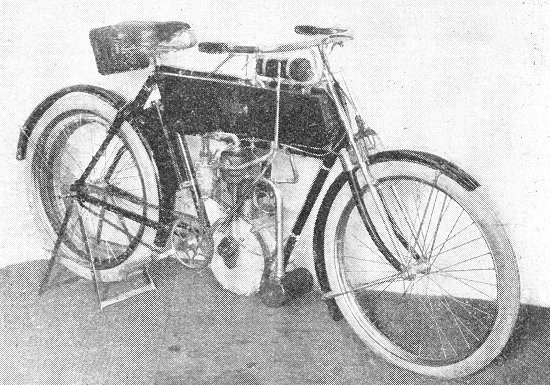 |
The Star 4 hp. water-cooled motor
bicycle. |
|
|
The 1904 catalogue lists two models, identical, except for
the engine. The first was fitted with a vertically mounted 2½
hp.
ZL engine, and the second with a vertically mounted 3 hp. ZL
engine. The specification is as follows:
|
Carburettor: |
Longuemare with an automatic air inlet |
|
Ignition: |
battery and coil |
|
Wheels: |
26 in. or 28 in. diameter |
|
Frame: |
23 inch frame, built from best weldless steel
tube. Every joint reinforced |
|
Forks: |
Triple plate crown, steel stamping, with extra
front forks |
|
Belt: |
V - chrome, leather |
|
Gear: |
Pedal gear, 56 in. |
|
Chain: |
½ in. pitch,
Brampton's |
|
Handle bars: |
Raised, 1 in. diameter. |
|
Brakes: |
Front rim brake, specially designed; rear band
brake actuated by a Bowden cable |
|
Tyres: |
Dunlop, 28 in. or 26 in. x 2 in. |
|
Saddle and
Bag: |
Good large size |
| |
|
|
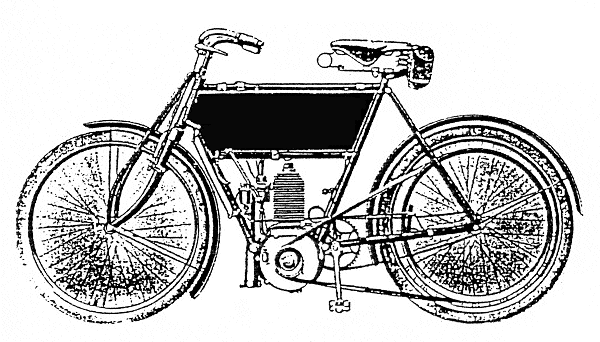
The 3 hp. machine from the 1904 catalogue.
Courtesy of Brian Rollings.
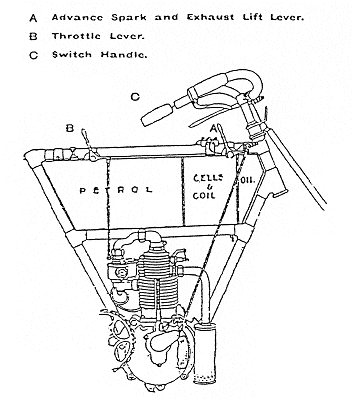 |
The 3 hp. machine sold for £46, and the 2½
hp. machine sold for £42.
The machines were available
with a Bowden free engine clutch, for an extra £6.
Star also launched 2¾ hp. and 3½
hp. models selling for 35 guineas, and 41 guineas respectively.
It is not known how many Star
motorcycles were produced, but it seems likely that sales were
not good, because production ceased in 1905. At the time a deep
depression had started in the bicycle trade with strong
competition from German and American imports.
A diagram from the 1904 catalogue. Courtesy
of Brian Rollings. |
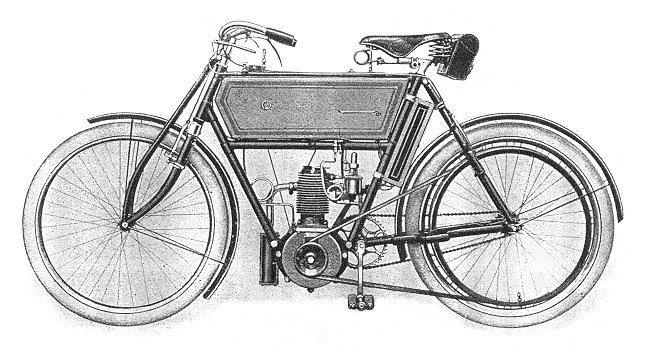
The 2¾ hp. Star.
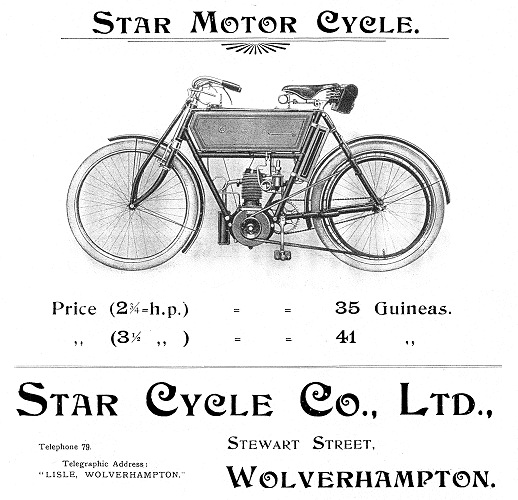
|
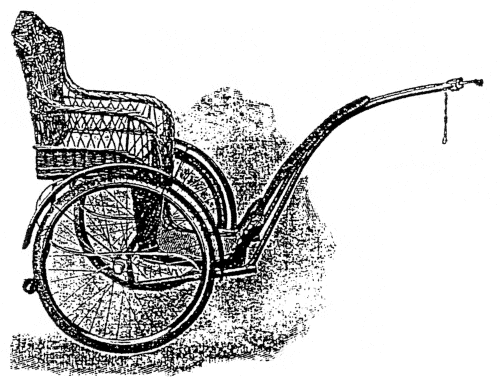
The Star Trailer. Courtesy of Brian Rollings. |
The 1904 catalogue included two trailers that were
suitable for use with bicycles or motorcycles.
The Star Trailer had
a wicker body and was fitted with a comfortable cushion.
It had 26 inch plated wheels which were fitted with
Warwick or Clipper tyres. It sold for £9. |
| The Star Tradesman's Carrier
had a seasoned wood body that was fitted with a lockable hinged zinc
top. It had 26 inch enamelled wheels and cushion tyres.
The basic
trailer sold for £9 and was available with fitted shelves for a
small extra charge. |
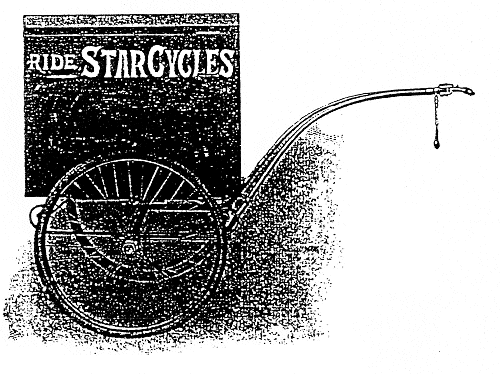
The Star Tradesman's Carrier. Courtesy
of Brian Rollings. |
| Star products could be paid-for in cash, or in
instalments. The Star Trailer above cost £9 when paid in
cash, whereas it cost £11 when paid in instalments.
A new
beginning
By 1912 motorcycles were becoming a popular form of
transport. As a result many new manufacturers were beginning
to appear, to cater for public demand. This is probably
why Star decided to return to motorcycle production during
that year. The following is an article about Star's new 4¼
hp. machine which was displayed at the Motorcycle Show. It
appeared in 'Motor Cycling' magazine on 5th November, 1912. |
|
The New Star Motor-Bicycle
An exceptionally interesting
self-contained power unit of practical and ingenious design.
Leather-to-metal clutch on the engine shaft. Three speed
gearbox. Chain drive.
The Star Cyc1e Co., although having
hitherto held aloof from the motorcycle industry, will
assuredly cause as much interest as any of the newcomers
with the 4¼ hp. single-cylinder machine which
they will stage for inspection at the forthcoming show, the essentials, viz.,
engine gearbox, clutch and carburettor, being of distinctly original design,
and, moreover, fine pieces of work: apart from such points of distinctiveness,
the whole of the power unit, comprising, in addition, the
magneto and foot-starter, is capable of detachment from the
machine en bloc, giving the model a note of originality and
value as regards this point exceeded by none of its
competitors.
Taking the engine, lubrication is forced to the
main bearings by centrifugal action, the oil entry being via
magneto chain case and timing case into a circular flanged
ring, cast on the off side flywheel, and receiving oil from
a guide web, cast integral with the crankcase, on its inner
wall, a hole being drilled through the timing case at this
point; centrifugal action delivers oil thence through the
drilled crank pin to the big end and through the drilled
connecting rod, which is a steel forging, to the small end,
being finally driven through the hollow gudgeon pin to the cylinder walls, every part being thus
well supplied from the sight drip feed oiler on the tank.
The cylinder head and valve chambers
form a separate casting, bolted down to the cylinder by four holding bolts, and is
a clean piece of work, the cooling fins being wide and thin,
and the valve ports large. The valves are 1⅞ in. diameter,
necessitating but about ½ in. lift, and the forward
holding-down bolts can be swung forward for drawing the
cylinder clear of the piston without removing the engine
from the frame.
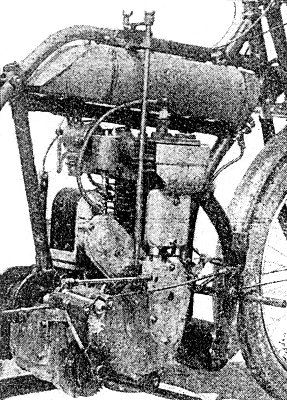
Timing side of the Star engine, showing
the foot starter and valve shield. |
Valves are
enclosed in an oil-tight aluminium
cover, and the piston is provided
with a stiffening flange round its
base, while ball bearings are fitted
to the clutch side of the main
shaft, in addition to the plain
bronze bush which is provided on
both sides.
The timing gear
is exceedingly neat and strong, only
one reduction wheel being employed,
the three cams, exhaust, inlet and
decompression, being cut from the
solid, and on one spindle, which is mounted on
Hoffman bearings.
The decompressor is among the neatest we
have inspected, calling for a minimum of space, an extension
arm of the exhaust lifter carrying a small slipper lever
rocker, which, under slight operation of valve lifter, is
rotated into position between the exhaust rocker arm and
decompressor cam, slightly lifting the valve at the end of
the compression stroke.
Further operation of the exhaust
lifter automatically takes the work off its shoulders, so to
speak. |
|
Very heavy flywheels of 10 in. diameter
are fitted, and the main bearings are most substantial.
One
of the beauties of the design permits the removal of the
timing box and outer half of the magneto chain case without
disturbing the mechanism in any degree, while the crankcase
casting is formed to provide two platforms at the rear.
Firstly, that to carry the magneto, and lower still,
rearward, a second, which fits under the centre bracket, to
which it is fastened by the four gearbox bolts passing
through both members from the gearbox unit
below, slotted holes allowing for ample adjustment.
The
crankcase lugs are arranged that the withdrawal of but three
bolts allows the removal of the power plant complete.
|
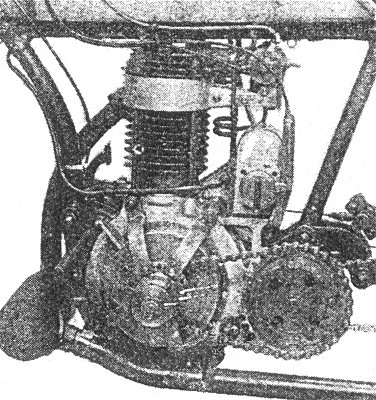
The Star power plant which can be
removed from the
frame, complete with gearbox, magneto
and clutch. |
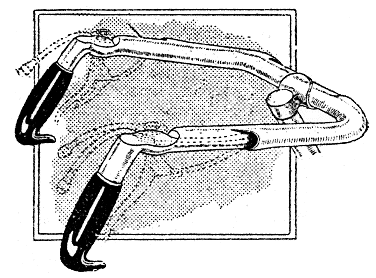
The Star handlebar showing special
dropped grips
with flats for taking control gear, and having
four
concealed cables. |
The clutch, again, strikes an
original note, being of the cone
type, leather to metal, and mounted
on an outer extension of the engine
shaft. It is cased-in, and
oil-tight, and operated by a pedal
at the extremity of the shaft, which
is locked to a cam-faced ring that
rotates thereon against a
similarly-faced sleeve-end carrying
the inner member of the clutch.
Depression of the pedal thus
thrusts the leather-covered cone out
of engagement with the rotating
outer member, which is fixed to the
engine shaft. On the sleeve carrying
the inner clutch member, a chain
sprocket carries the drive to the
gearbox, the countershaft of which
is similarly fitted, and final drive
is also by this means. |
The gears are of the sliding type, with direct
on top, operated through a sturdy lever, horizontally
rotated, operating in a notched quadrant attached to the top
tube. In fact, car practice is closely followed throughout
the transmission, and a very sound job it is, an oil-bath
chain case enclosing the drive from engine to countershaft,
while a spring drive is incorporated in the chain wheel to
absorb shock.
The carburettor is a new design multi-jet, and
will probably be fitted as a two-lever for standard,
although single-lever operation can be successfully
employed. Three spray holes cover the jets, and
over their faces slides the grooved throttle barrel, with a
lateral motion, uncovering the holes in progression, the
movement simultaneously opening up the hot air intake at the
base.
An additional air lever operates a rotating sleeve
segment between the throttle barrel and housing, thus giving
further access to the hot air chamber, which is a further
neat point in design. An aluminium collar casting, in two
halves, embraces the upper radiating pins, and feeds, the
carburettor with warm air; this should assist somewhat in
cooling the engine.
Reverting to the gearbox for a moment,
both shafts are mounted on ball bearings, and the gear
wheels are of generous dimensions, while a large inspection
door forms the rear side. A good foot-starter-pinion and
segment is also fitted on the gear shaft in a convenient
position. Bore and stroke are 89 mm. by 100 mm. and a desaxe
setting has been adopted for the cylinder.
Valanced
mudguards, with a hinged rear member for easy tyre repair,
will be fitted, and needle valve petrol cocks for both
carburettor and cylinder priming find a place on the tank. |
|
| The 1914 catalogue features two models, a 4¼
hp. machine and a 6 hp. V-twin machine. The 4¼ hp. machine
sold for 65 guineas, the 6 hp. machine sold for 75 guineas. |
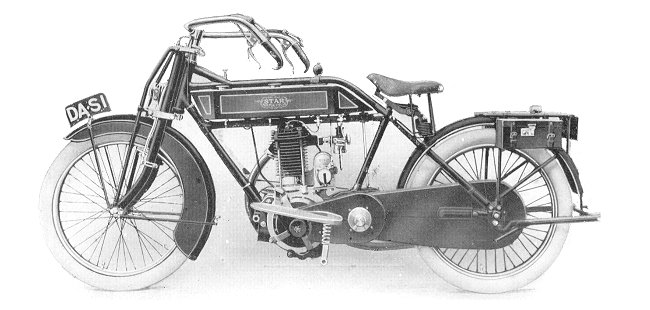
The Star 4¼ hp.
machine.
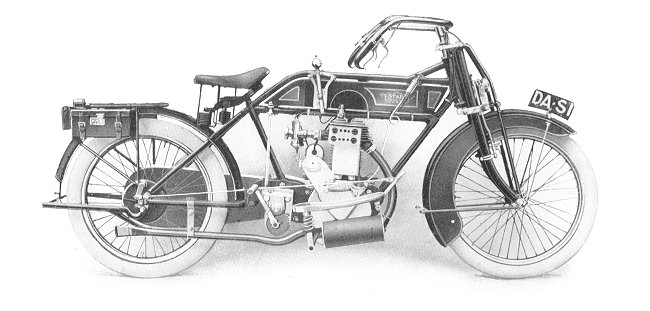
Another view of the Star 4¼
hp. machine.
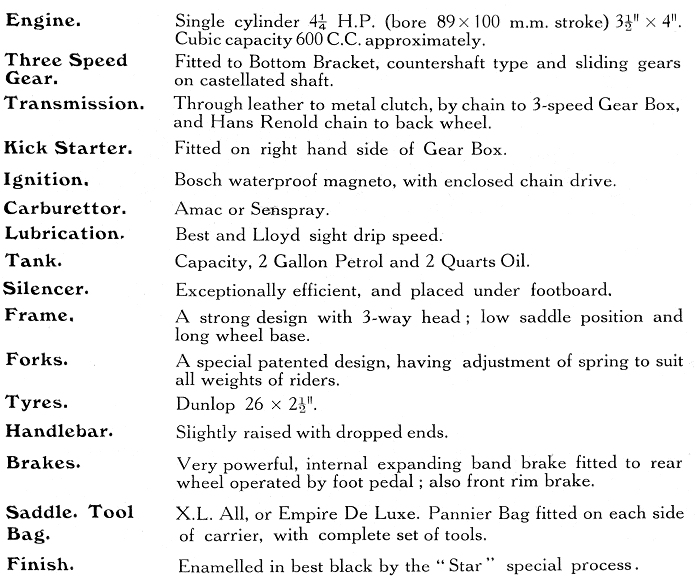
The specification of the Star 4¼
hp. machine.
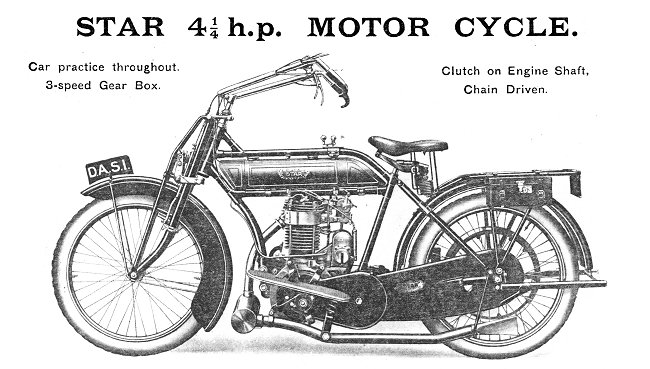
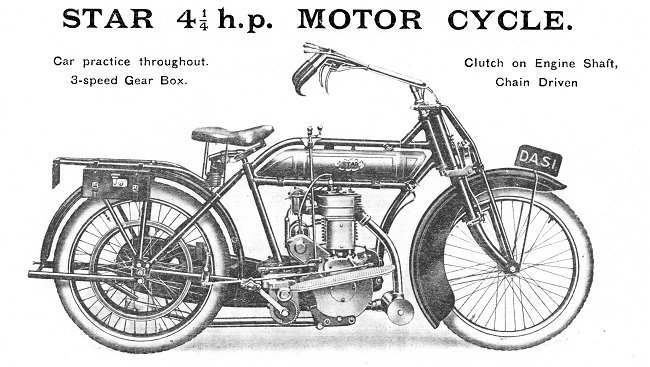
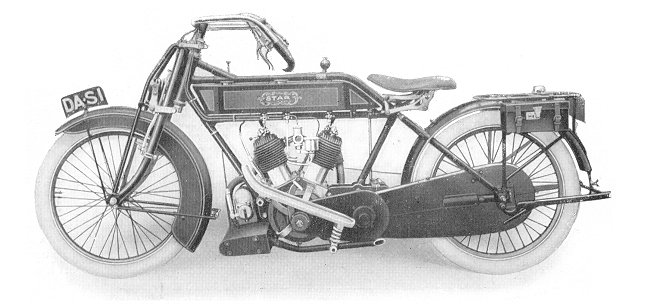
The Star 6 hp.
machine.
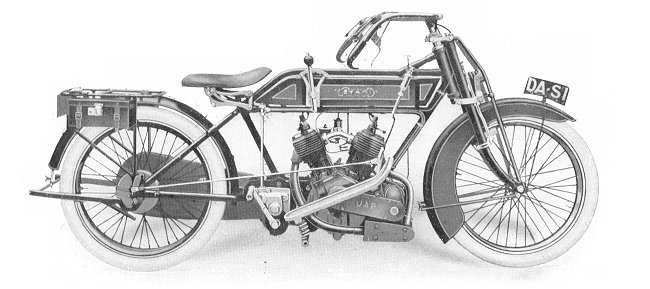
Another view of the Star 6
hp. machine.
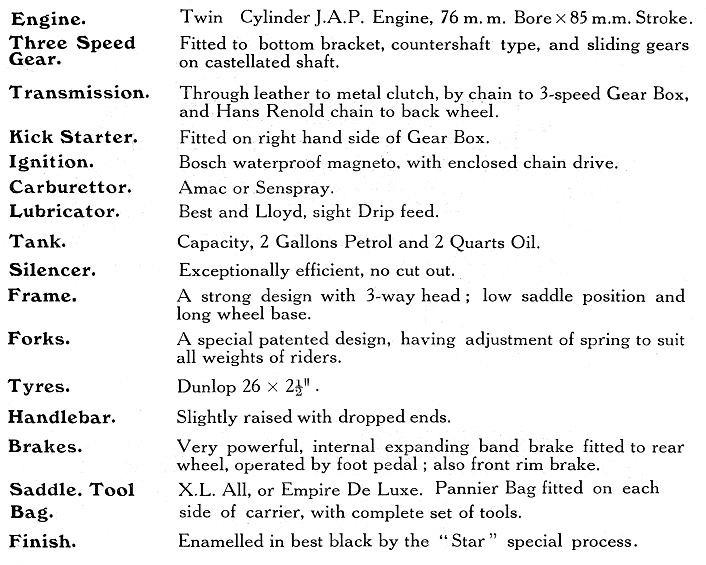
The specification of the Star 6
hp. machine.
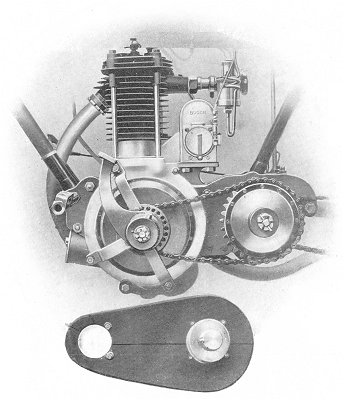
The 4¼
hp. engine showing the clutch, and the slipping clutch, with
the chain case removed. |
|
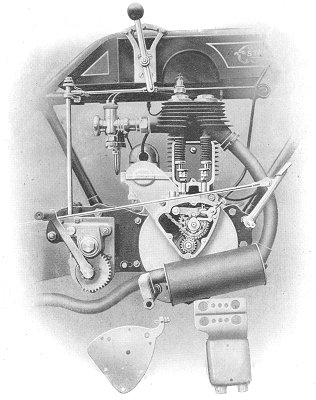
The 4¼
hp. engine with timing gear and valve cover removed, showing
timing gear, valves, kick starter and speed change lever. |
|
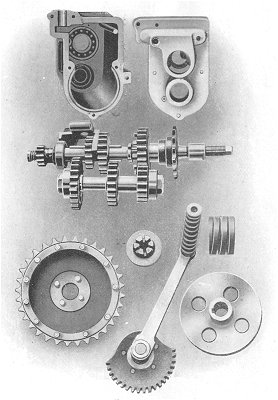
Gearbox parts. |
|
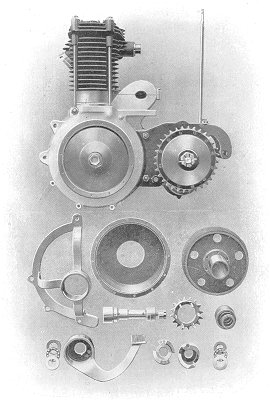
The 4¼
hp. engine showing the clutch
parts and slipping device. |
| The 4¼ hp. engine could be
removed from the frame complete with gearbox, magneto and
clutch. It had a very heavy 10 inch flywheel which had
substantial bearings. |
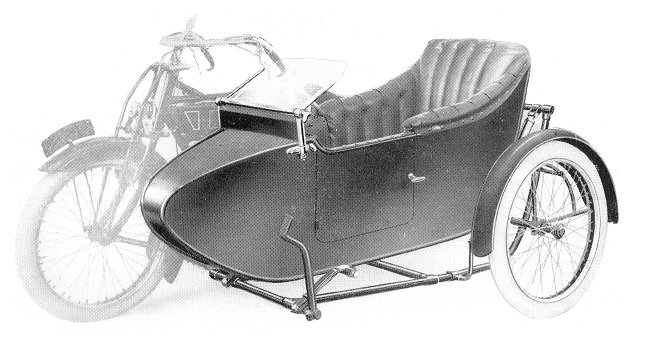
The Star coach-built sidecar. Price with tyre 16
guineas.
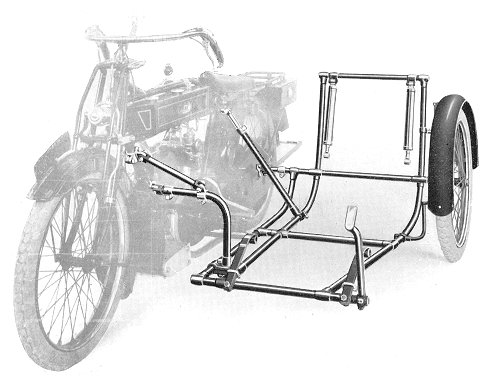
The sidecar chassis.
| The Star sidecar had a specially strengthened frame with
a double tube running the whole length. Suspension was
provided by two spring plungers, attached to a cross member
at the back, and small laminated springs at the front. The
chassis was enamelled in black, with plated fittings. The
body was coach built, and provided with a sprung seat. It
was richly upholstered. A hood and windscreen were available
as extras. |
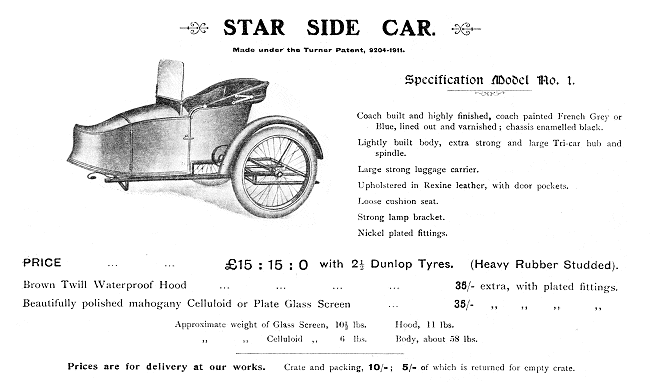
The Star sidecar Model 1.
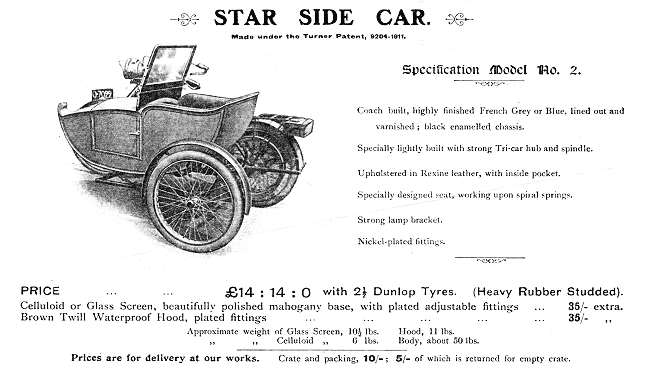
The Star sidecar Model 2.
|
Production was short-lived. After the
outbreak of war in 1914 Star became a controlled
establishment, with output devoted to the war effort. As a
result motorcycle production came to an end. It is not known
how many Star motorcycles were produced. It is thought to be
only a small number. |
|